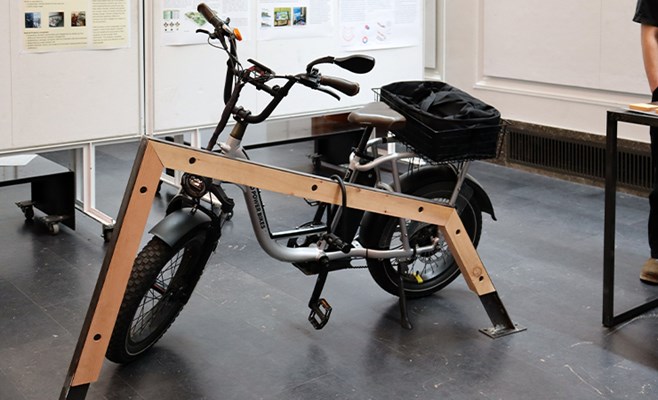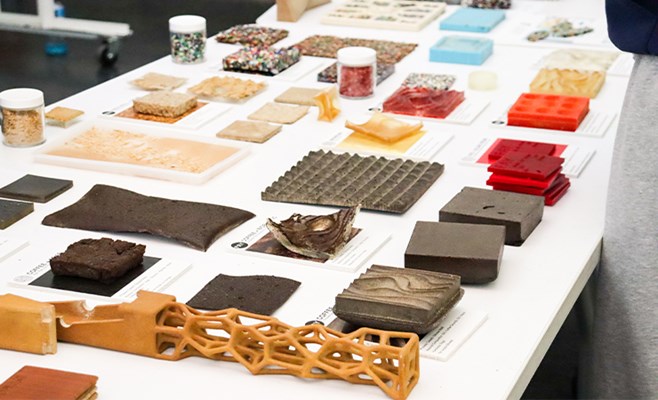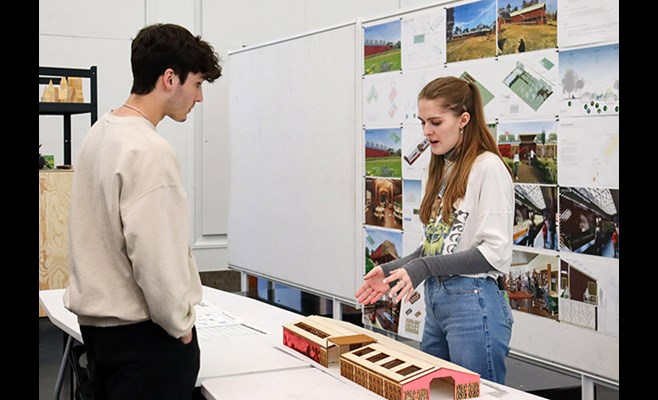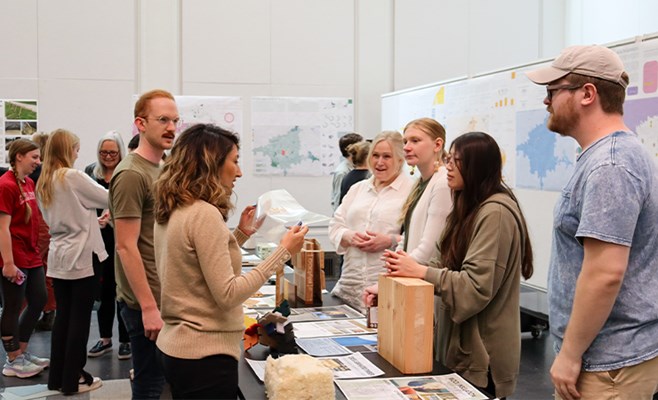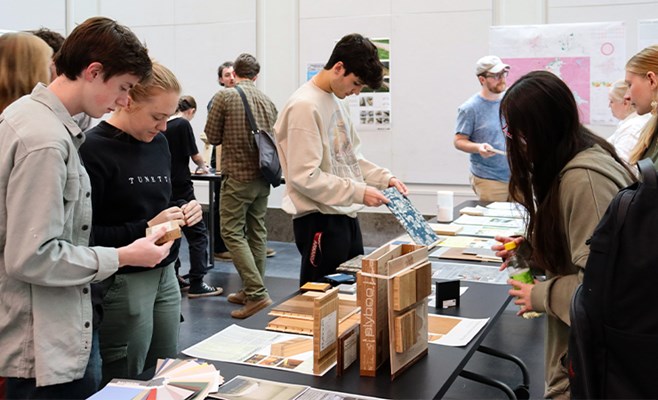Fay Jones School's Earth Day Event Spotlights Sustainable Materials and Projects

Students learn about sustainable materials during an Earth Day event hosted April 22 by the Fay Jones School of Architecture and Design, held in the second floor gallery of Vol Walker Hall.
The Fay Jones School of Architecture and Design hosted an Earth Day event on April 22, celebrating sustainability in the built environment.
"Humans have created drastic imbalances on our planet, but we can fix them," said Jennifer Webb, associate professor of interior architecture and design. "One day doesn't seem like a lot, but one day can empower individuals and groups, energize them to work for change and innovate for transformative solutions."
A prominent part of the event, held in Vol Walker Hall, was displaying student work from previous semesters.
For this event, the student staff in the school's Materials Lab researched less toxic and more renewable materials and products that can be used when designing and constructing buildings. This is especially important because construction materials are a major contributor to landfills, said Kim Furlong, associate professor of interior architecture and design.
The students presented an engaging display of about 20 innovative and sustainable products from the Materials Lab collection. Each was presented with a report on its ingredients and its benefits and considerations for the environment.
They presented two alternatives to standard carpet, which is made with nylon, a petroleum-based fiber that is not typically recycled at the end of its life. The first, woven carpet made from renewable sheep wool and goat cashmere, does not use toxic adhesives and is 100% biodegradable. The second is a carpet made from recycled nylon with a bio-resin backing whose manufacturer provides a recycling program that retrieves the carpet for it to be recycled again at the end of its current use.
Other products on display included sustainable linoleum flooring, made from a mixture of wood or cork flour, linseed oil and pine resin on a jute fiber backing; and renewable wool batt insulation, an alternative to the ubiquitous fiberglass batt insulation found in most residential walls and roofs today.
Students who work in the school's Fabrication Build Lab as fabrication shop assistants presented their prototype for a proposed bike rack installation on the Tsa La Gi Trail, near the Build Lab off of Martin Luther King Jr. Boulevard.
Max Holt, a fourth-year architecture student, said the project aims to support the growing active transportation needs at the Build Lab and across Fayetteville.
"Biking is a more sustainable way to get around in comparison to driving cars," Holt said. "We're looking at installing six racks in the coming months."
The bike rack's design allows for versatility in how it's used. It is structured with a shorter end, to fit smaller kids' bikes, and with a taller end that fits full suspension mountain bikes and electric bikes. The steel frame of the bike rack provides a rigid, strong structure. Wood extends past the steel frame, to prevent bikes chained to it from getting scratched.
The project, still in the prototyping phase, will be installed this summer. It will act as an educational demonstration for the surrounding area. Hunter Craig, a fifth-year architecture student, and Sally Senn (B.Arch. '23) are also on the project's design fabrication team.
Sophie Forrer, a fourth-year interior architecture and design student, presented her fall studio project, a redesign of Heifer Ranch, which addresses the Living Building Challenge.
"This project is important to sustainability because it shows how architecture, interior architecture and design, and landscape architecture are important together to have a sustainable future," Forrer said.
In addition to project designs, the event also included displays of sustainable materials for use in future models and projects.
Angela Carpenter, Build Lab director, shared examples of healthy model making materials and exhibited sustainable materials being developed through the Fabrication Lab. She said the samples represent nearly five years of research.
"In 2019, I really got into experimenting with wood waste — how can we use more sustainable binders, using it with 3D printing and casting?" Carpenter said.
Carpenter and her team have also been experimenting with mixing discarded coffee grounds with bioplastics and bio-resins. All the materials have a range of how biodegradable they are. Some of the resins contain up to 30% biobased content; however, they have experimented with an algae-based cast polyurethane that is at least 56% biobased. The bioplastics and other natural binders are 100% sustainable.
The Build Lab also has been experimenting with melting discarded PLA (polylactic acid) 3D printing filament donated by Push Plastic and forming them in silicone molds, Carpenter said. Some tests include embedding the pellets in 3D printed ceramic tiles for studying different architectural applications.
"We've got a really good team that is helping to develop this material research," Carpenter said. "They are very critical for making this work happen."
While some of the wood-based products resulted from work done in studios, the other types resulted from the team's own curiosity as they worked in the lab. Long term, Carpenter said they hope to see how their research can be applied at larger scales.
"Events like Earth Day celebrations contribute to mindfulness and, hopefully, inspire someone to take the next step, and then another," Webb said. "Also, it's just so cool to see what amazing things we are all working on. One day and one person won't change things, but all of us working together, each on a part of the problem, will make a difference."
The event also included Fabrication Lab models, health and wellness posters linking a healthy environment to healthy people, Sustainability Capstone (SUST 4103) posters and bioplastic totes with a DIY maker experience (check out this recipe for making a bioplastic bag).
Drew Gobbi, a third-year interior architecture and design student, presented her honors capstone prospectus poster about the use of mushroom mycelium as an innovative building material. Attendees also had a chance to chat with representatives from the U of A Office for Sustainability.
Contacts
Tara Ferkel, communications specialist
Fay Jones School of Architecture and Design
479-575-4704, tferkel@uark.edu
Michelle Parks, director of communications
Fay Jones School of Architecture and Design
479-575-4704, mparks17@uark.edu
